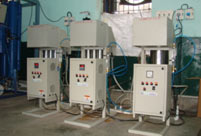 |
|||
| Turnkey | Consultants | Construction | Filtration | Ozonation | UV System | Accessories | Chemicals |
| Architects Corner | Channel Partner | Photo Gallery | Client List | Case Studies |
| Swimming Pool Ozonation | |
|
Swimming pool disinfection is necessary to create a healthy and safe environment for pool. When most chlorine treatments are first added to pool water, they produce free chlorine as hypochlorous acid and hypochlorite ion residuals. These chemicals react very quickly to both oxidize and disinfect the contaminants introduced by both swimmers and the environment. This residual mechanism is advantageous due to the continuous addition of debris and germs by patrons requiring immediate treatment. Due to its relative low cost and high effectiveness in this role, chlorine continues to be used prominently around the world. When chlorine reacts with organic compounds, it may only partially oxidize the compounds resulting in intermediate products known as disinfection by-products (DBPs). A very strong “chlorine” smell is caused by DBPs and may be indicative of poor pool water chemistry. Chloramines, the most common DBPs, are directly attributable to swimmers complaints of skin irritation and eye burn. The long term effect of chloramines can also have devastating effects to dehumidifying equipment and metallic supports as. |
|
|


